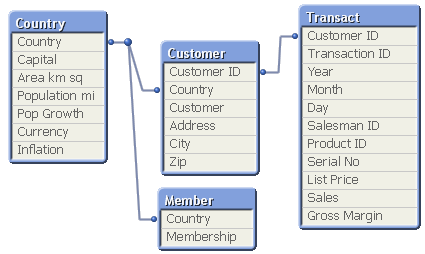A database can have many tables. Each table can be considered as a list of something; each record in the list represents an instance of an object of some type.
Example:
If two tables are lists of different things, for example if one is a list of customers and the other a list of invoices, and the two tables have a field such as the customer number in common, this is usually a sign that there is a relationship between the two tables. In standard SQL query tools the two tables should almost always be joined.
The tables defined in the QlikView script are called logical tables. QlikView makes associations between the tables based on the field names, and performs the joins when a selection is made, for example selecting a field value in a list box.
This means that an association is almost the same thing as a join. The only difference is that the join is performed when the script is executed - the logical table is usually the result of the join. The association is made after the logical table is created - associations are always made between the logical tables.

QlikView association compared to SQL natural outer join
A QlikView association resembles a SQL natural outer join. The association is however more general: an outer join in SQL is usually a one-way projection of one table on another. An association always results in a full (bidirectional) natural outer join.
Frequency information in associating fields
There are some limitations in the use of most associating fields, that is, fields that are common between two or more tables. When a field occurs in more than one table, QlikView has a problem knowing which of the tables it should use for calculating data frequencies.
QlikView analyzes the data to see if there is a non-ambiguous way to identify a main table to count in (sometimes there is), but in most cases the program can only make a guess. Since an incorrect guess could be fatal (QlikView would appear to make a calculation error) the program has been designed not to allow certain operations when the data interpretation is ambiguous for associating fields.
Limitations for associating fields
- It is not possible to display frequency information in a list box showing the field.
- Statistics boxes for the field show n/a for most statistical entities.
- In charts, it is not possible to create expressions containing functions that depend on frequency information (such as Sum, Count functions, and Average) on the field, unless the Distinct modifier is activated. After each reload, QlikView will scan all chart expressions to see if any ambiguities have occurred as a result of changes in data structures. If ambiguous expressions are found, a warning dialog will be shown and the expression will be disabled. It will not be possible to enable the expression until the problem has been corrected. If a log file is enabled, all ambiguous expressions will be listed in the log.
Workaround
There is a simple way to overcome these limitations. Load the field an extra time under a new name from the table where frequency counts should be made. Then use the new field for a list box with frequency, for a statistics box or for calculations in the charts.
